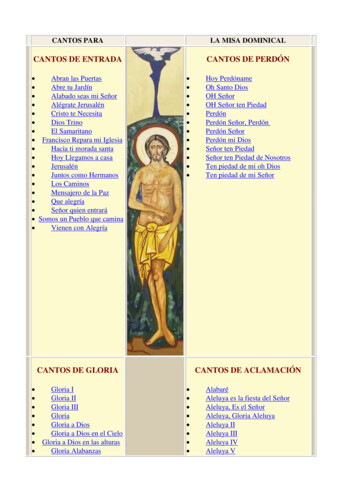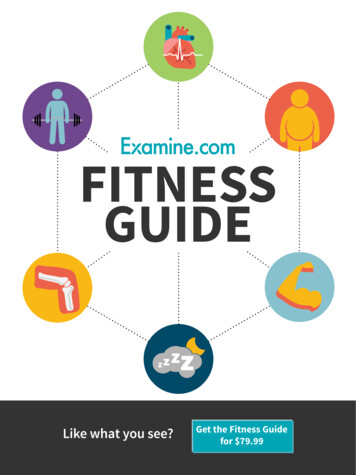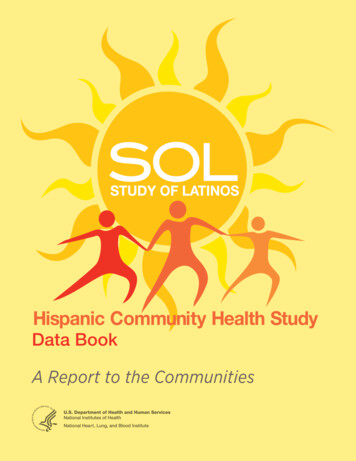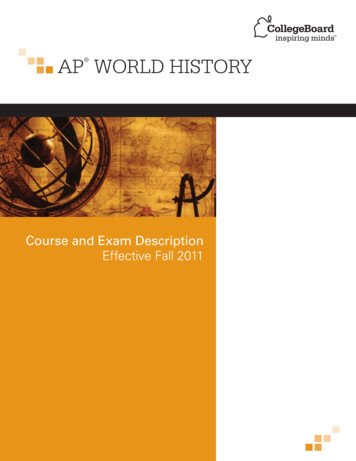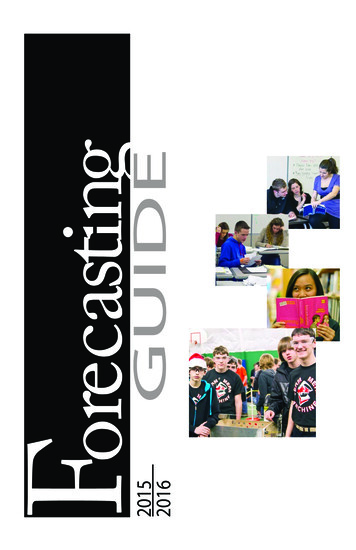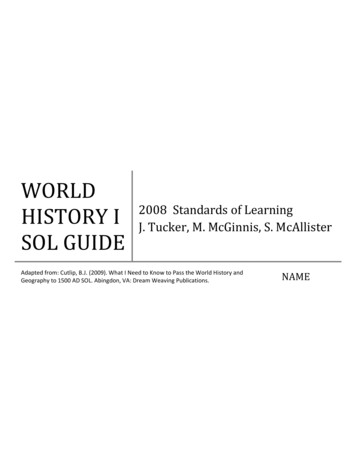
Transcription
WORLDHISTORY ISOL GUIDE2008 Standards of LearningJ. Tucker, M. McGinnis, S. McAllisterAdapted from: Cutlip, B.J. (2009). What I Need to Know to Pass the World History andGeography to 1500 AD SOL. Abingdon, VA: Dream Weaving Publications.NAME
Human Origins – Prehistory to 1000 B.C.E. (WHI. 2)Paleolithic Era to the Agricultural Revolution (2a)The lifestyle of early humans was shaped by their physical ENVIRONMENTo FIRE FOR WARMTH AND PROTECTIOBNo ANIMAL SKIN CLOTHINGHomo sapiens emerged in AFRICA between 100,000 and 400,000 years ago.Homo sapiens migrated from AFRICA to EURASIA, AUSTRALIA and the AMERICASEarly humans were HUNTERS and GATHERERS whose survival depended on the availability of WILD PLANTS forgathering and WILD ANIMALS for hunting.Label the following:AfricaAsiaEuropeNorth AmericaSouth AmericaPacific OceanAtlantic OceanUse arrows to demonstrate the migration path ofearly humans. Beginning in Eastern Africa andending in South America.Paleolithic Era (2b)( OLD Stone Age)“Hunter-gatherer society”Were NOMADIC (migrated in search of food, water, andshelter)Invented the first tools, including simple WEAPONSLearned how to make and use FIRELived in CLANS (small family groups)Developed a SPOKEN language (oral)Created “ CAVE ART ”Neolithic Era (2c)( NEW Stone Age)“Agricultural society”Developed AGRICULTURE (domestication ofplants)Domesticated ANIMALS (food andprotection)Used advanced TOOLS (made of stone,wood, and bone)Made POTTERY (storage of food, etc.)Developed WEAVING SKILLS (no longerdepended on animal skins for clothing)Describe two ways that archaeologists work to study past cultures (2d)LOCATE AND INTERPRET EVIDENCE OF EARLY HUMANS AND THEIR LIVESLOCATE AND ANALYZE (RADIO-CARBON DATING) EARLY HUMAN REMAINSWhat is the example of an archaeological site found in England? When was this site constructed?STONE HENGESTARTED DURING THE NEOLITHIC ERA AND COMPLETED IN THE BRONZE AGEWhat are the names of the three early permanent settlements and in what modern-day country were they located?JERICHO – ISRAEL, ALEPPO – SYRIA, CATAL HUYUK - TURKEYOn the map below, label each of the early permanent settlements, then highlight the area of the Fertile Crescent inJ. Tucker (2012)WHAT I NEED TO KNOW TO PASS THE WORLD HISTORY I SOL GUIDE 1
green.CATAL HUYUKALEPPOJERICHOWHI.3Name two reasons early humans settled in river valleys during the New Stone AgeFresh water for humans, animals, and plantsFertile soil for farmingFour known ancient civilizations all developed around river valleys. Give the name of the civilizationthat developed on each of the listed rivers. Find and label the rivers on the map below. (3a)Indus River Valley INDUS CIVILIZATIONColor the location GreenNile River Valley and Delta EGYPTIAN CIVILIZATIONColor the location RedTigris and Euphrates River Valleys MESOPOTAMIAN (SUMER/BABYLON) Color the location PurpleHuang He Valley CHINESE CIVILIZATIONColor the location OrangeJ. Tucker (2012)WHAT I NEED TO KNOW TO PASS THE WORLD HISTORY I SOL GUIDE 2
When did the four early river civilizations above develop?BETWEEN 3500 AND 500 B.C.Which of the civilizations developed in Asia?MESOPOTAMIAN, INDIAN, CHINESE CIVILIZTIONSWhich of the civilization (s) developed in Africa?EGYPTIANJ. Tucker (2012)WHAT I NEED TO KNOW TO PASS THE WORLD HISTORY I SOL GUIDE 3
Other early civilizations (Developed around 2000 to 500 B.C.E.) (3a)The HEBREW settled between the Mediterranean Sea and the JORDAN River valley.The Phoenicians settled along the MEDITERRANEAN COAST This was also part of the Fertile Crescent inSouthwest ASIA.Nubia was located on the upper NILE River, south of Egypt in AFRICAOn the map, label thelocation of the settlements ofthe Nubians, Hebrew, and thePhoenicians that existedbetween 2000 to 500 B.C.E.Shade the area of the FertileCrescent green.Map created using MapMakers Toolkit.What were some of the characteristics of the Early River Civilizations?(3b)SocialPoliticalHEREDITARY rulers. (rule passed fromCreated the world’s firstone family member to another)GOVENMENTS (empires, citystates, kingdoms)Rigid class systems where SLAVERYCentralized governments oftenbased on conquest or debit was accepted.based on RELIGIOUS authority.Had WRITTEN law codes (Codeof Hammurabi, TenCommandments)EconomicIRON AND BRONZE toolsand weapons.Increasing AGRICULTURALSURPLUS led to an increasein populationIncreasing trade along riversand by seaDevelopment of the world’sfirst CIVILIZATIONSSpecialization of laborExpand your KnowledgeA PHARAOH or KING is an example of a hereditary ruler.CODE OF HAMMURABI and TEN COMMANDMENTS are examples of the first written codes of law.Some of the earliest tools and weapons were made of BRONZE or IRONSome reasons why agricultural surpluses were possible are:BETTER TOOLS, IRRIGATIONWhat are some examples of the world’s first political states?KINGDOMS, CITY-STATES, EMPIRES J. Tucker (2012)WHAT I NEED TO KNOW TO PASS THE WORLD HISTORY I SOL GUIDE 4
Religion was a major part of life in all early civilizations. As religions developed there were two majortraditions – monotheism and polytheism (3c, d) Polytheism (belief in more than one god or in many gods) was practiced by most CIVILIZATIONS Monotheism ( the belief in only one god) was practiced by the HEBREW The monotheism of Abraham became the foundation of JUDAISM, CHRISTIANITY, and ISLAM religions that changed the world. The Hebrew were the first to practice MONOTHEISMJudaism (3d)Origins of JudaismBeliefs, traditions and customs of JudaismSpread of Judaism Belief in ONE God (monotheism)Exhile Abraham The body of work that contains theDiaspora Moseswritten records and beliefs of theThe Exile was the enslavement andremoval of Jews from Palestine after JerusalemHebrews is called the TORALHtheir Babylonian capitivity. Ever since(Holy City) The Ten Commandments were thethat time communities of Jews haveMORAL LAWS and ETHICAL conductlived outside their homeland.*Diaspora is a Greek word meaning“scattered”Explain each of the following:AbrahamTorahMosesTen CommandmentsJerusalemDiasporaExile (507-538 B.C.E.)Babylonian CaptivityJudaismHebrewsExamples of Early Codes of Law. Match the laws with their source.1If a man has commmitted highway robbery and1. Code of Hammurabihas been caught, that man shoud be put to death2. Ten Commandments(22)1If a free man has destroyed the eye of a memberof the aristocracy, they shall destroy his eye (196)2Thou shalt not covet . . . anything that is thyneighbor’s. (10)2Thou shalt not steal. (8)Explain each of the following: (3e)1. Alphabet4earliest written symbols2. Cuneiform3Egyptians3. Hieroglyphics4. Pictograms2Sumerians1PhoeniciansNOTE:Be sure to understand what each of these forms of writinglooked like.WHI.4PersiaBuilt on earlier Central Asian and Mesopotamian civilizations, Persia developed the largest empire in the world.The Persians were tolerant of CONQUERED PEOPLE (often accepting their languages, religions, and laws.The Persians developed an imperial BUREAUCRACY to govern the empire.One of the religions that developed during this time period was ZOROASTRIANISM (Zoroaster was a prophet who believedthat humans struggled to choose between good and evil with rewards or punishments leading to either paradise or hell. He isbelieved to have influenced Judaism, Christianity, and Islam.)The Persians developed a ROAD SYSTEM(i.e., The Royal Road was more than 1,500 miles long with stationsplaced frequently for food, water, and fresh horses.)J. Tucker (2012)WHAT I NEED TO KNOW TO PASS THE WORLD HISTORY I SOL GUIDE 5
Label the following, then outlinethe Persian Empire.Mediterranean SeaBlack SeaArabian SeaPersian GulfIndus RiverTigris/Euphrates RiversNile RiverGreeceArabian PeninsulaCaucasus MountainsAfricaAsiaEuropeINDIA (4b)GeographyClassical Indian civilization began in the Indus RiverValey and aspread to the Ganges River Valley, thenthrough the Indian subcontinent. It continued withlittle interruption because of its geographic location.Physical barriers such as the HIMALAYASthe Hindu Kush, and the INDIAN Oceanmade invasion more difficult.Mountain passes in the HINDU KUSHprovided invasion routes into the Indiansubcontinent.The INDUS RIVER and GANGES RIVERwere the most important rivers in the Indiansubcontinent.Indian OceanLabel the following on the map of India:Ganges River Himalayas Hindu Kush Indian Ocean Indus RiverIndiaThe Indo-Aryan people invaded the area, creating a rigidly structured society (CASTE SYSTEM) blended with native beliefs. Therigid caste system was HEREDITARY and influenced all social interactions and choices of OCCUPATION (One was born into a group– and that group could not be changed – which influenced that person’s profession, neighborhood, and social class.The GUPTA Empire was the Golden age of classical Indian culture. Among the contributions were:MATHEMATICS, TEXTILES, LITERATUREExpanded information on the Gupta Empire:The Gupta Empire is credited with advancing the development of the principles of algebra. This empire also expanded theconcept of infinity and developed the concept of zero. Their symbols for the numbers 1 to 9 were adopted by traders from theMiddle East and later became known as “Arabic numerals” in the West.Indian eporters traded cloth, notably cotton, as well as silk from China, by land and sea spreading the culture by means ofJ. Tucker (2012)WHAT I NEED TO KNOW TO PASS THE WORLD HISTORY I SOL GUIDE 6
products and ideas.The Gupta rulers valued learning. They encouraged learning from the Upandishads. Hinduism was the religion of the empire.Many epics and poems came from this era. One famous sermon is called the Bhagavad Gita.HINDUISMBUDDHISMHinduism influenced Indian society and culture and is still practiced in IndiaBuddhism was founded in a part of India that is intoday.present-day NEPALCaste system in religious law was based on OCCUPATIONFounder: SIDDHARTHA GAUTAMA (laterknown as the Buddha)Belief in many forms of one major DIETY or GODFour Noble TRUTHSCycles of rebirth: REINCARNATIONEightfold Path to ENLIGHTENMENTFuture reincarnation based on present behavior: KARMAAsoka’s* missionaries and their writings preadSacred writings: VEDAS and UPANISHADSBuddhism from India to CHINA and other parts ofSOUTHEAST ASIA*Legend has it that after one very brutal battle, Asoka rode about thebattlefield and saw the dead, dying, and maimed bodies. He was so struckby the horror that he announced that he would begin following the teachingsof Buddha. He became a man of peace. He sent missionaries throughoutIndia and Asia to spread the word of Buddha.Chinese forms of Buddhism spread throughout Asia as other religions were formed.CHINA (4e)Classical China was centered on the HUANG HE(Yellow River) and was geographically isolated.Migratory invaders entered China from the NORTH.The GREAT WALL was built for China’s protection byQIN SHI HUANGDI as a line of defense againstinvations.China was governed by a succession of ruling familiescalled DYNASTIES Chinese rulers were consideredYellow Seadivine, but they served under a MANDATE OFHEAVEN only as long as their rule was just.EastChinese culture began around 1500 B.C. Of ChineseChinacontributions to civilization, SILK and PAPER are thePacificSeamost noted. The SILK ROAD facilitated trade andOceancontact between China and other cultures as far awayas Rome.Label the following: Yellow Sea, East China Sea, Sea of Japan, PacificOcean, Himalayas, Plateau of Tibet, Gobi Desert, Taklamakan Desert,Huang He, Yangtze RiverContributions of Classical ChinaCivil service systemPorcelainPaperSilkExpanded information:Mandate of Heaven – In ancient China the Chinese believed that if their rulers we doing well, they were ruling under a mandate (or theauthority to rule) that came from heaven. If crops failed or battles were lost, the ruler had lost the mandate. Someone else then starteda new dynasty.Civil Service System – System that allowed those other than nobility to hold publicoffice. If someone was recommended for a positionand then passed a very long and very difficult test, he could hold public office. This system made scholars highly respected in Chinesesociety and provided talented people to run the government.CONFUCIANISM (Originated in China)TAOISM (Originated in China)Characteristics:Characteristics:Hellped form social order of CHINAHelped form CHINESE culture and valuesBelief that humans are GOOD not EVILFOUNDED BY LAZOIRespect for ELDERSSimple life and INNER PEACECode of POLITENESS still used in Chinese society todayHarmony with NATUREJ. Tucker (2012)WHAT I NEED TO KNOW TO PASS THE WORLD HISTORY I SOL GUIDE 7
Emphasis on EDUCATIONANCESTOR worshipYIN AND YANG represented opposites for Confucianism and Taoism.SILK ROADSThe Silk Roads (network of trade routes) wasopened under the Han ruler Wudi. These traderoutes moved products from China to Rome andback. The Chinese had a monoply on theproduction of silk which was a highly desiredproduct in Europe. Gold, wool, and otherEuropean products were traded for the silk. TheSilk Roads helped to improve the economoy ofChina and contributed to the spread of Chineseidead and inventions.WHI.5Geography (5a)The physical geography of the Aegean Basin shaped the economic, social, and political development of GREEKcivilization.The expansion of Greek civilization, through trade and colonization, led to the spread of HELLENIC (GREEK) cultureacross the Mediterranean and Black Seas.Label the locations of the following:Aegean SeaGreek peninsula, Europe, Asia Minor,Mediterranean SeaBlack sea, Dardanelles (narrow straitconnecting Aegean Sea with Sea of Marmaraleading to the Black Sea)Athens, Sparta, Troy, ByzantiumMacedoniaBorders have changed somewhat through the years. During theearly Greek civilization, Macedonia was located to the north ofGreece. The Greeks were conquered by the Macedonians underthe leadership of Philip II and Alexander the Great.Greece’s Early Development (5a)Economic and social developmentJ. Tucker (2012)Political developmentWHAT I NEED TO KNOW TO PASS THE WORLD HISTORY I SOL GUIDE 8
Agriculture (limited ARABLE land or farmable land) – due to the manymountainsCommerce and the spread of HELLENIC cultureShift from barter to MONEY economy (use of coins)Greek MythologyMountainous terrain helped and hindered thedevelopment of city-statesGreek cities were designed to promote CIVIC andCOMMERCIAL lifeColonization was related to overpopulation and thesearch for ARABLE (FARMABLE) land.Greek gods and goddessesBased on POLYTHEISTIC religionExplanantions of natural phenomena, human qualities, and lifeevents.Zeus, Hera, Ares, Hades, Apollo, Artemis, Athena,and AphrodietSymbols and images in Western literature, art,monumental architecture, and POLITICSBelieved gods/goddesses lived on MOUNTOLYMPUSSocial structure and citizenship in the Greek polis (5c)Classical Athens developed the most democratic system of government the world had ever seen, although not everyone couldparticipate in decision-making. It became a foundation of modern democracies. Contrasting philosophies of government divided theGreek city-states of Athens (DIRECT DEMOCRACY) and Sparta (DICTATORIAL)Citizens (free adult males) had political rights and the responsibility of civic participation in government.Women and foreigners had no political rights.Slaves had no political rightsAthensSpartaStages in evolution of Athenian governmentOligarchy (Rule by SMALL GROUPRigid social structureMILITARISTIC and AGGRESSIVEMonarchyAristocracyTyrannyDirect DemocracyTyrants who worked for reform: Draco, SOLONOrigin of democratic principles: Direct DEMOCRACY. publicDEBATE, duties of the citizenThe Early Greeks at War (5d)Importance of Persian Wars (499-449 B.C.E.)Persian Wars united ATHENS and SPARTA against the PersianEmpire.Athenian victories over the Persian Empire at MARATHON andSALAMIS left Greeks in control of the Aegean Sea.Athens preserved its independence and continued innovations ingovernment and culture.J. Tucker (2012)Importance of Peloponnesian War (431-404 B.C.E.)Caused in part by competition for control of the Greekworld – Sparta and the PELOPONNESIAN LEAGUEvs. Athens and the DELIAN LEAGUEAthens forced to surrender, which resulted in theslowing of cultural advances and the weakening ofpolitical powerWHAT I NEED TO KNOW TO PASS THE WORLD HISTORY I SOL GUIDE 9
Marathon and Salamis were two cities in Greece that were successfully defended against the Persians. Legend has it that anAthenian runner ran the 26 miles from Marathon to Athens to announce the Persian defeat before dropping dead. Today’smarathons of 16.2 miles originate from this heroic story.During the Peloponnesian War Athens was defeated by Sparta which weakened the city-states – leading eventually to problemswhen they are up against Macedonia for their very survival.Classic Era (5e,f)(Athenian culture during this era became one of the foundation stones of Western civilization)Golden Age of Pericles* (mostly occurring between the Persian and the Peloponnesian Wars)Pericles extended DEMOCRATIC PARTICIPATION: most adult males had an equal voice.Pericles had Athens rebuilt after destruction in the PERSIAN WARS; the PARTHENON is an example of this reconstruction.AreaNeed to knowAeschylusAeschylus wrote the only complete TRILOGY that exists today from the first Greek dramaORESTIA. These plays are about the TROJAN WARSophoclesSophocles was a Greek DRAMATIST whose most famous play was OEDIPUS REX In thisplay an oracle predicts that Oedipus will kill his father and marry his mother – which Oedipusunknowingly does in the playHomer (Iliadand OdysseyHomer was a Greek POET believed to have been BLIND. Homer wrote the ILIAD (about theTROJAN War) and the Odyssey (about the adventures of Odysseus – or Ulysses after theTrojan WarHerodotusHerodotus, known as the ”FATHER of HISTORY”, was thought by some to be the first GreekHISTORIAN. He wrote about the conflict between the GREEKS and the PERSIANS in hisHistory of the Persian Wars.ThucydidesThucydides was also a Greek HISTORIAN who was an Athenian GENERAL during thePeloponnesian War. After he lost in battle, he was exiled where he wrote his History of thePeloponnesian War. Thucydides strived for ACCURACY and objectiveness in his eTypes ofcolumnsincluding Doric(Parthenon),Ionic, andCorinthianPhidias wan an Athenian SCULPTOR and the artistic director of the construction of thePARTHENON. He completed a statue of Zeus for the Temple of Zeus at Olympia. Thiscolossal statue is now considered to be one of the Seven Wonders of the Ancient World.Of the three types of columns found in Greece, DORIC columns are the most basic and undecorative. They contain no base to enhance their design. These were the main type ofcolumns used for the PARTHENONThe IONIC style is a little more decorative with the CORINTHIAN the most decorative of all –as said by some to be the most appealing to the modern eye.ArchimedesArchimedes was a MATHEMATICIAN who was also an INVENTOR of many practical objectsincluding PUMPS for irrigation and mines, as well as weapons for war. He is known for hiswork with cylinders and spheres and for computing the value of PI – and also for his theory onthe DISPLACEMENT of water which is often told in a story about his screaming “Eureka!” whilerunning naked from his bath (also known as the Archimedes’ Principle).HippocratesHippocrates was a famous Greek DOCTOR who also developed the HIPPOCRATIC OATHwhich is a code of ethics that DOCTORS still take today. Also considered to be “The Father ofModern Medicine.”ScienceJ. Tucker (2012)Expanded information for understanding and REMEMBERINGWHAT I NEED TO KNOW TO PASS THE WORLD HISTORY I SOL GUIDE 10
MathematicsMathematicsPythagorasEuclidOften described as the first pure MATHEMATICIAN Pythagoras and his students are said tohave developed the first proof that, for a RIGHT triangle, a2 b2 c2 (the sum of the squaresof the two sides of a triangle is equal to the square of the hypotenuse – commonly known asthe PYTHAGOREAN THEOREM. Many of Pythagoras’ ideas had been used by theBABYLONIANS one thousand years before Pythagoras proved on paper why they worked.Euclid brought together much of the knowledge of the mathematics known as GEOMETRY.He defined abstractions such as points and lines. Euclid set down general rules calledAXIOMS. His way of geometry was called Euclidean geometry.Socrates was a PHILOSOPHER who spent his life in pursuit of true knowledge. Socrates triedto remain conscious of how much he did not know, and claimed superiority to unthinking peopleonly in that he was aware of his own ignorance where they were not.SocratesPhilosophyPlatoAristotleHe taught his followers to search for ANSWERS about man’s role in the universe. Hequestioned Athenian VALUES and was accused of “forming an idea of revolt.” He wasaccused of teaching his students to QUESTION and THINK for themselves. For this type ofthinking, he was sentenced by the Greek government to die by drinking the poison, hemlock.Plato was a student of Socrates and later carried on his work. He gathered Socrates’ ideasand wrote them down. People all over the world can now study the Greek philosophers. Platofounded his ACADEMY for research and instruction in philosophy and the SCIENCES. Healso wrote a book about government called THE REPUBLICWhen Aristotle was seventeen, he traveled from MACEDONIA to ATHENS to study with Plato.Aristotle thought of an axiomatic system and deductive reasoning. Among Aristotle’ writingswere books about physics, poetry, ZOOLOGY, BIOLOGY, politics, and governments. Hethought that the goal of humankind was to achieve happiness. He is thought to have been thetutor of ALEXANDER THE GREAT.Macedonian Conquest (5g)(followed the weakening of Greek defenses during the Peloponnesian Wars)Philip II, King of MacedonAlexander the GreatHellenistic AgeConquered most of GREECEEstablished an empire from Greece toBlend of Greek andAFRICA and the margins of INDIAORIENTIAL elementsAdopted GREEK culture and spreadSpread of HellenisticHellenistic influences throughout his vastculture through TRADEempireExtended HELLENISTIC cultural influences.ALEXANDER THE GREAT’s EMPIREJ. Tucker (2012)WHAT I NEED TO KNOW TO PASS THE WORLD HISTORY I SOL GUIDE 11
Label the Following:GreeceIndiaEgyptMesopotamiaNile RiverIndus RiverTigris RiverEuphrates RiverMediterranean SeaBlack SeaRed SeaPersian GulfArabian SeaWHI.6Ancient Rome (6a)The city of Rome, with its central location on the Italian PENINSULA was able to extend its influence over the entireMediterranean Basin. The Italian peninsula was protected by the sea and an arc of mountains, the ALPSNote location of the following:Rome – Centrally located inthe MEDITERRANEANBasin and distant fromeastern MediterraneanpowersItalian PeninsulaAlps – protectionMediterranean Sea –Protection, sea-bornecommerceThe Governance of the Roman Republic (6c)Social structure in the RomanRepublicJ. Tucker (2012)CitizenshipFeatures of Roman DemocracyWHAT I NEED TO KNOW TO PASS THE WORLD HISTORY I SOL GUIDE 12
PATRICIANS - powerful nobility (fewin number)PLEBIANS - majority of thepopulationSLAVES - Not based on raceOnly the following were citizens:REPRESENTATIVE democracyPatrician and plebian MENAssembliesSelected FOREIGNERSThe SENATEThe rights and responsibilities ofcitizenship included TAXES andMILITARY SERVICEConsulsLaws of Rome codified as theTWELVE TABLESAlthough WOMEN, most ALIENS (non-Romans living in the Republic), and SLAVES were excluded from the governingprocess, the Roman Republic made major strides in the development of representative democracy, which became afoundation of modern DEMOCRACYSpreading the Roman Culture (6d)After the victory over Carthage in the Punic Wars, Rome was able, over the next 100 years, to dominate theMediterranean Basin, leading to diffusion of Roman culture.Punic Wars: Rome v. Carthage (264-146 B.C.Rome and CARTHAGE were in competition for tradeHANNIABAL invaded the Italian Peninsula in the Second Punic WarThree wars resulted in Roman victory, the destruction ofCARTHAGE and expanded trade and wealth for ROMEEvolution of the Roman Empire andspread of Roman cultureMediterranean Basin (Africa, Asia,Europe, including the HELLENSITICworld of the Eastern Mediterranean)Western Europe (Gaul (modernFrance), BRITISH ISLES)More information about the Punic Wars:264-241 B.C. war concentrated onthe island of Sicily; the Romans beatthe Carthaginians.218-202 B.C. Hannibal, a greatCarthaginian general, crossed theAlps with his army – won every battlebut lost the war and was exiled fromItaly. Rome gained control of thewhole western Mediterraneanincluding Spain and northern Africa.149-146 B.C. conquest of theHellenistic empires to the east anddestruction of the city of Carthage –which expanded trade and wealth forRome.From Roman Republic to Roman Empire (6e, f)The Roman REPUBLIC in the face of changing social and economic conditions, succumbed (fell to CIVIL war and wasreplaced by an IMPERIAL REGIME the Roman Empire.J. Tucker (2012)WHAT I NEED TO KNOW TO PASS THE WORLD HISTORY I SOL GUIDE 13
Causes for the decline of the Roman RepublicThe origin and evolution of Imperial RomeSpread of SLAVERY in the agricultural systemMigration of small farmers into cities andUNEMPLOYMENTCivil war over the power of JULIUS CAESARDevaluation of Roman currency; INFLATIONFirst TRIUMVIRATE (government where thepower is shared by three people)Julius Caesar – seizure of power;assassinatedAugustus Caesar - Civil war; defeated MARCANTHONY became Rome’s first emperorEmpire – unified and enlarged, using imperialauthority and the militaryFailure to provide for peaceful succession ofEMPERORSInformation to Assist with Understanding the Early Roman EmpireBy the second century B.C., the Senate was the governing body of the Roman state. An economic crisis arose as smallfarmers, unable to compete with large landowners using slaves, lost their farms and drifted to the cities creating a large classof landless poor.The need for soldiers (who were often recruited by generals with a promise of land ownership) led to a shift in sworn loyalty tothe generals rather than the Roman state. As individual generals gained command, civil wars arose as various individualsbegan to compete for power.The First Triumvirate was formed in the first century B.C. (of which Julius Caesar and Pompey were two of the threemembers). These Triumvirate members were often in charge of leading soldiers into battle. After the third Triumviratemember was killed in battle, Caesar and Pompey fought for control. Caesar won after he secretly crossed the River Rubiconand started another civil war.Caesar hen became dictator, but he was soon assassinated by a group of his leading senators.The Second Triumvirate ( of which Marc Anthony and Octavian –later named Augustus Caesar- were members) was formed.Again a battle for power between two of the members (Octavian and Anthony) led to political unrest.After teaming up with Cleopatra (the Queen of Egypt), Marc Anthony was defeated by Octavian. Both Anthony and Cleopatracommitted suicide after this defeat leaving Octavian in power.Julius Caesar and Marc Anthony had both been in love with and had children with CleopatraWith Marc Anthony’s death, Octavian was in command of the Roman world. IN 27 B.C. the Roman Senate gave Octavian thename of Augustus, meaning “the revered one”. He became the first Roman emperor. This title gave him command of thearmy which allowed him to rule and expand his influence. At this point the civil wars ended, as did the republic.Pax Romana and Its Impact (6g)Augustus Caesar established the Roman Empire by instituting CIVIL SERVICE, rule by LAW a common COINAGE andsecure TRAVEL and trade throughout the empire. Following Augustus Caesar, the Roman Empire enjoyed 200 years ofpeace and prosperity known as the PAX ROMANAThe Pax RomanaEconomic impact of the Pax RomanaTwo centuries of peace and prosperity under IMPERIAL ruleExpansion and solidification of Roman Empire, particularly inthe NEAR EASTSocial impact of the Pax RomanaEstablished uniform system of money, whichhelped to EXPAND TRADEGuaranteed safe travel and trade on ROMANROADESPromoted prosperity and stabilityPolitical impact of the Pax RomanaReturned stability to SOCIAL CLASSESIncreased emphasis on the FAMILYCreated a CIVIL SERVICESDeveloped a uniform RULE OF LAWChristianity (6h)The followers of JESUS spread Christianity throughout the Roman Empire, bringing it into conflict with Roman polytheismand eventually changing WESTERN civilization.J. Tucker (2012)WHAT I NEED TO KNOW TO PASS THE WORLD HISTORY I SOL GUIDE 14
Origins of ChristianityBeliefs, traditions, and customs ofChristianityHad its roots in JUDAISMWas led by Jesus ofNazareth, who wasproclaimed the MESSIAHConflicted withPOLYTHEISIC beliefs ofthe Roman EmpireSpread of ChristianityMonotheismJesus as both SON andINCARNATION of GodLife after DEATHNEW TESTAMENT containingaccounts of the life and teachings ofJesus, as well as writings of earlyChristiansChristian doctrine established byearly CHURCH COUNCILSCarried by the Apostles, includingPAUL throughout the RomanEmpireSlowed as a result ofPERSECUTION by RomanauthoritiesAdopted and legalized byEMPEROR CONSTANTINE(Legend has it that this emperor had avision of the sign of the Christ that turnedhim to Christianity. He was the first emperorto honor Christians instead of persecutingthem.)Church in Rome Grew in Importance, Membership and Influence (6i)Impact of the Church of Rome in the late Roman EmpireChurch became an example of MORAL authority.Loyalty to the church became more important than loyalty to the EMPERORChurch became main unifying force of WESTERN EUROPEDecline of the Roman Empire (6k)Over a 300-year period, the western part of the Roman Empire steadily declined because of internal and externalproblems.Causes for the decline of the Western Roman EmpireEconomy – cost of DEFENSE and de
WORLD HISTORY I SOL GUIDE 2008 Standards of Learning J. Tucker, M. McGinnis, S. McAllister Adapted from: Cutlip, B.J. (2009). What I Need to Know to Pass the World History and Geography to 15
